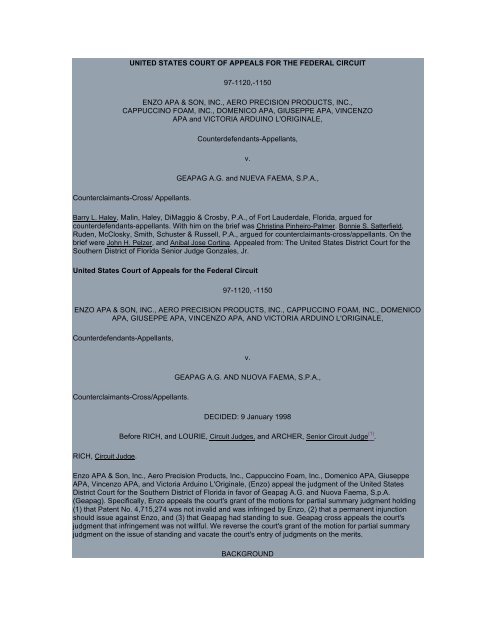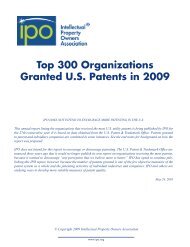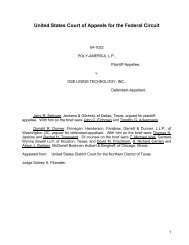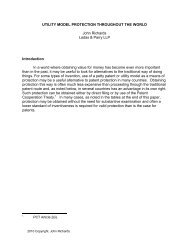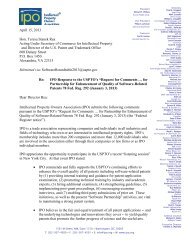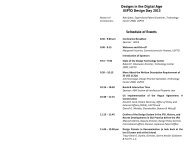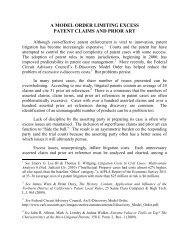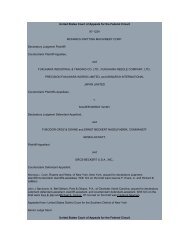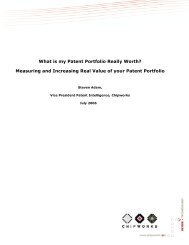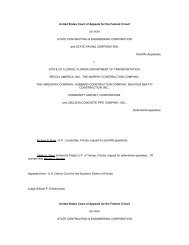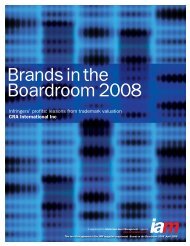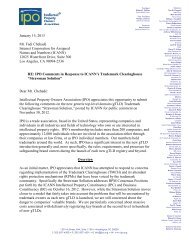Enzo APA & Son, Inc. v. Geapag A.G.
Enzo APA & Son, Inc. v. Geapag A.G.
Enzo APA & Son, Inc. v. Geapag A.G.
Create successful ePaper yourself
Turn your PDF publications into a flip-book with our unique Google optimized e-Paper software.
UNITED STATES COURT OF APPEALS FOR THE FEDERAL CIRCUIT<br />
97-1120,-1150<br />
ENZO <strong>APA</strong> & SON, INC., AERO PRECISION PRODUCTS, INC.,<br />
CAPPUCCINO FOAM, INC., DOMENICO <strong>APA</strong>, GIUSEPPE <strong>APA</strong>, VINCENZO<br />
<strong>APA</strong> and VICTORIA ARDUINO L'ORIGINALE,<br />
Counterdefendants-Appellants,<br />
v.<br />
Counterclaimants-Cross/ Appellants.<br />
GE<strong>APA</strong>G A.G. and NUEVA FAEMA, S.P.A.,<br />
Barry L. Haley, Malin, Haley, DiMaggio & Crosby, P.A., of Fort Lauderdale, Florida, argued for<br />
counterdefendants-appellants. With him on the brief was Christina Pinheiro-Palmer. Bonnie S. Satterfield,<br />
Ruden, McClosky, Smith, Schuster & Russell, P.A., argued for counterclaimants-cross/appellants. On the<br />
brief were John H. Pelzer, and Anibal Jose Cortina. Appealed from: The United States District Court for the<br />
Southern District of Florida Senior Judge Gonzales, Jr.<br />
United States Court of Appeals for the Federal Circuit<br />
97-1120, -1150<br />
ENZO <strong>APA</strong> & SON, INC., AERO PRECISION PRODUCTS, INC., CAPPUCCINO FOAM, INC., DOMENICO<br />
<strong>APA</strong>, GIUSEPPE <strong>APA</strong>, VINCENZO <strong>APA</strong>, AND VICTORIA ARDUINO L'ORIGINALE,<br />
Counterdefendants-Appellants,<br />
v.<br />
GE<strong>APA</strong>G A.G. AND NUOVA FAEMA, S.P.A.,<br />
Counterclaimants-Cross/Appellants.<br />
DECIDED: 9 January 1998<br />
Before RICH, and LOURIE, Circuit Judges, and ARCHER, Senior Circuit Judge (1) .<br />
RICH, Circuit Judge.<br />
<strong>Enzo</strong> <strong>APA</strong> & <strong>Son</strong>, <strong>Inc</strong>., Aero Precision Products, <strong>Inc</strong>., Cappuccino Foam, <strong>Inc</strong>., Domenico <strong>APA</strong>, Giuseppe<br />
<strong>APA</strong>, Vincenzo <strong>APA</strong>, and Victoria Arduino L'Originale, (<strong>Enzo</strong>) appeal the judgment of the United States<br />
District Court for the Southern District of Florida in favor of <strong>Geapag</strong> A.G. and Nuova Faema, S.p.A.<br />
(<strong>Geapag</strong>). Specifically, <strong>Enzo</strong> appeals the court's grant of the motions for partial summary judgment holding<br />
(1) that Patent No. 4,715,274 was not invalid and was infringed by <strong>Enzo</strong>, (2) that a permanent injunction<br />
should issue against <strong>Enzo</strong>, and (3) that <strong>Geapag</strong> had standing to sue. <strong>Geapag</strong> cross appeals the court's<br />
judgment that infringement was not willful. We reverse the court's grant of the motion for partial summary<br />
judgment on the issue of standing and vacate the court's entry of judgments on the merits.<br />
BACKGROUND
This controversy began on January 27, 1993, when <strong>Enzo</strong> brought an action for declaratory judgment against<br />
<strong>Geapag</strong>, seeking a judgment of patent invalidity and noninfringement of Patent No. 4,715,274 (the '274<br />
patent). Shortly thereafter, <strong>Geapag</strong> brought a separate action against <strong>Enzo</strong> for patent infringement and<br />
sought injunctive relief and damages. The cases were consolidated in Florida district court at the parties'<br />
request.<br />
In October 1993, <strong>Enzo</strong> filed a request for reexamination of the '274 patent before the United States Patent<br />
and Trademark Office (the PTO). Litigation was stayed until the PTO issued a reexamination certificate<br />
confirming the patentability of the '274 patent claims. At that time, <strong>Geapag</strong> moved for a partial summary<br />
judgment on the issues of standing, invalidity and infringement. In turn, <strong>Enzo</strong> filed a cross-motion for partial<br />
summary judgment of patent invalidity.<br />
In April 1995, the court granted the motion for partial summary judgment on the issue of standing, holding<br />
that <strong>Geapag</strong> had standing, and ordered a hearing on the issue of invalidity and infringement. After the<br />
hearing, the court held the '274 patent not invalid and infringed. On <strong>Geapag</strong>'s motion in April 1996, the court<br />
issued a permanent injunction against <strong>Enzo</strong> and granted Nuova Faema S.p.A.'s motion for judgment of<br />
dismissal with prejudice and entry of a protective order. The court denied Nuova Faema S.p.A.'s motion for<br />
sanctions against <strong>Enzo</strong>. Finally, the court found, sua sponte, that infringement was not willful. This appeal<br />
followed.<br />
DISCUSSION<br />
On appeal, <strong>Enzo</strong> objects, inter alia, that <strong>Geapag</strong> lacked standing to bring an action under U.S. Patent No.<br />
4,715,274 (the '274 patent), because <strong>Geapag</strong> was a non-exclusive licensee at the time the claims and<br />
counterclaims were filed on May 14, 1993 and February 26, 1993. We review standing de novo. See Rite<br />
Hite Corp. v. Kelley Co., 56 F.3d 1538, 1551, 35 USPQ2d 1065, 1074 (Fed. Cir.) (in banc), cert. denied, 116<br />
S.Ct. 184 (1995).<br />
In order to adjudicate <strong>Enzo</strong>'s appeal on the standing issue, we must trace the chain of title to the patent.<br />
Application for the '274 patent was filed on January 31, 1986, claiming priority from two Italian patent<br />
applications--19311 A/85 and 22947/85[U] (the Italian applications). The '274 patent issued on December<br />
29, 1987, with Luciano Paoletti named as the inventor and Spidem, S.r.L. (Spidem) named as the assignee<br />
of record.<br />
On December 4, 1987, Spidem allegedly granted an exclusive license to Joplin and Knox Ltd. (J&K) under<br />
the Italian applications (the Spidem-J&K License). As there is no copy of the Spidem-J&K License in the<br />
record, we do not know whether this license extended to the '274 patent. However, this is of no moment.<br />
Even if the Spidem-J&K License extended to the '274 patent, the subsequent license granted by J&K to<br />
<strong>Geapag</strong> did not. J&K granted an exclusive sublicense to <strong>Geapag</strong> to make and sell product under the Italian<br />
applications (the J&K-<strong>Geapag</strong> License). By its terms, the J&K-<strong>Geapag</strong> License does not extend, either<br />
implicitly or explicitly, to related or corresponding foreign patent applications or any patents maturing<br />
therefrom. In fact, it is specifically limited to the Italian applications and two other Italian patent applications<br />
listed on the face of the agreement.<br />
It follows that on February 3, 1988, when <strong>Geapag</strong> granted Nuova Faema S.p.A., M. Schaerer AG, and<br />
Cafag Kaffeemaschinen AG, nonexclusive sublicenses to use product, and a limited right to sell product<br />
under a number of related patents including the '274 patent, it did not actually have the power to convey<br />
those rights.<br />
It was not until well after the various actions and counteractions of both <strong>Enzo</strong> and <strong>Geapag</strong> were filed in<br />
district court, that <strong>Geapag</strong> and Spidem sought to clear the chain of title to the '274 patent retroactively. On<br />
October 15, 1993, <strong>Geapag</strong> and Spidem entered into an agreement through which the Spidem-J&K and the<br />
J&K-<strong>Geapag</strong> Licenses were canceled and an exclusive licensing arrangement was entered into between<br />
Spidem and <strong>Geapag</strong> (the Spidem-<strong>Geapag</strong> License).<br />
By its terms, the Spidem-<strong>Geapag</strong> License is retroactive, effective as of December 4, 1992, thus predating<br />
the first filed action. It grants <strong>Geapag</strong> the exclusive right to make, distribute, use and sell the products and<br />
methods under the originally identified Italian applications and "related and corresponding Italian and foreign<br />
patent applications and all patents maturing therefrom and extensions thereof", inter alia, the '274 patent.
<strong>Geapag</strong> alleges that the Spidem-<strong>Geapag</strong> License was a memorialization of the pre-suit oral agreement of<br />
the parties. The Spidem-<strong>Geapag</strong> License is the only asserted written transfer of rights to <strong>Geapag</strong> of record<br />
with respect to the '274 patent.<br />
The Patent Act (the Act) provides that a "patentee" shall have remedy by civil action for patent infringement.<br />
35 U.S.C. 281 (1994). The term "patentee" is defined in the Act under section 100(d) as including not only<br />
the patentee to whom the patent issued, but the successors in title to the patentee. This has been<br />
interpreted to require that a suit for infringement must ordinarily be brought by a party holding legal title to<br />
the patent. See, e.g., Arachnid, <strong>Inc</strong>. v. Merit Indus., <strong>Inc</strong>., 939 F.2d 1574, 1578-79, 19 USPQ2d 1513, 1517-18<br />
(Fed. Cir. 1991).<br />
Accordingly, an assignee is the patentee and has standing to bring suit for infringement in its own<br />
name. See 35 U.S.C. 100(d) (1994). The assignment of legal title in a patent can be conveyed in the form of<br />
the entire patent, an undivided part or share of the entire patent, or all rights under the patent in a specified<br />
geographical region of the United States (a so called "grant"). See Waterman v. Mackenzie, 138 U.S. 252<br />
(1891) (addressing the predecessor patent statute). Any less than a complete transfer of these rights is<br />
merely a license, in which case the title remains with the owner of the patent and the suit must be brought in<br />
its name. Id.<br />
We have accorded standing, in certain limited circumstances, where all substantial rights under the patent<br />
have been transferred in the form of an exclusive license, rendering the licensee the virtual assignee. Vaupel<br />
Textilmaschinen KG v.Meccanica Euro Italia S.p.A., 944 F.2d 870, 20 USPQ2d 1045 (Fed. Cir. 1991). <strong>Geapag</strong><br />
argues that it was the virtual assignee under the terms of the nunc pro tunc Spidem-<strong>Geapag</strong> License<br />
agreement, which allegedly memorialized the oral license agreement. It alleges that the terms of the<br />
exclusive license were to make, use, and sell the licensed products and the exclusive right to sue for<br />
infringement of the patent rights.<br />
It is clear from the record that there was no writing transferring all substantial rights under the '274 patent to<br />
<strong>Geapag</strong> at the time it brought suit. Thus, we must then determine whether an oral exclusive license or a<br />
nunc pro tunc license executed after suit is brought, or some combination of the two, can confer standing.<br />
We conclude that under any of these circumstances the holder of title must be joined in order to confer<br />
standing.<br />
First, <strong>Geapag</strong> argues that it should be of no consequence that the rights were not memorialized in writing<br />
prior to entering into the Spidem-<strong>Geapag</strong> License. It points out that a license may be written, verbal, or<br />
implied. While we acknowledge that a license may be written, verbal, or implied, if the license is to be<br />
considered a virtual assignment to assert standing, it must be in writing. The limited exception we have<br />
provided conferring standing on licensees is restricted to virtual assignees. As such, the licensing<br />
arrangement conferring such must, logically, resemble an assignment in both form and substance. Under<br />
the 35 U.S.C. 261 (1994), "[a]pplications for patent, patents, or any interest therein, shall be assignable in<br />
law by an instrument in writing." If we were to expand the exception to include verbal licenses, the exception<br />
would swallow the rule. Parties would be free to engage in revisionist history, circumventing the certainty<br />
provided by the writing requirement of section 261 by claiming to be patentee by virtue of a verbal licensing<br />
arrangement.<br />
Second, <strong>Geapag</strong> argues that the nunc pro tunc Spidem-<strong>Geapag</strong> License, which was entered into October<br />
15, 1993, and made effective December 4, 1992, renders it a virtual assignee for the purposes of standing.<br />
However, as has been aptly stated, nunc pro tunc assignments are not sufficient to confer retroactive<br />
standing on the basis that:<br />
As a general matter, parties should possess rights before seeking to have them vindicated in court. Allowing<br />
a subsequent assignment to automatically cure a standing defect would unjustifiably expand the number of<br />
people who are statutorily authorized to sue. Parties could justify the premature initiation of an action by<br />
averring to the court that their standing through assignment is imminent. Permitting non-owners and<br />
licensees the right to sue, so long as they eventually obtain the rights they seek to have redressed, would<br />
enmesh the judiciary in abstract disputes, risk multiple litigation, and provide incentives for parties to obtain<br />
assignment in order to expand their arsenal and the scope of litigation. Inevitably, delay and expense would<br />
be the order of the day.
Proctor & Gamble Co. v. Paragon Trade Brands, <strong>Inc</strong>., 917 F. Supp. 305, 310, 38 USPQ2d 1678, 1682 (D. Del.<br />
1995) . <strong>Geapag</strong> has not provided us with any reason to stray from this sound reasoning to confer standing<br />
based on a retroactive licensing arrangement, regardless of its terms.<br />
Accordingly, we reverse the court's grant of the motion for partial summary judgment on the issue of<br />
standing. Having found <strong>Geapag</strong> to be without standing for failing to join the patentee, it follows that the court<br />
lacks jurisdiction over <strong>Enzo</strong>'s declaratory judgment claims under Fed. R. Civ. P. 19 for nonjoinder. Thus, we<br />
vacate the court's entry of judgments on the merits.<br />
REVERSED AND VACATED<br />
1. *Senior Circuit Judge Archer vacated the position of Chief Judge on December 24, 1997.


